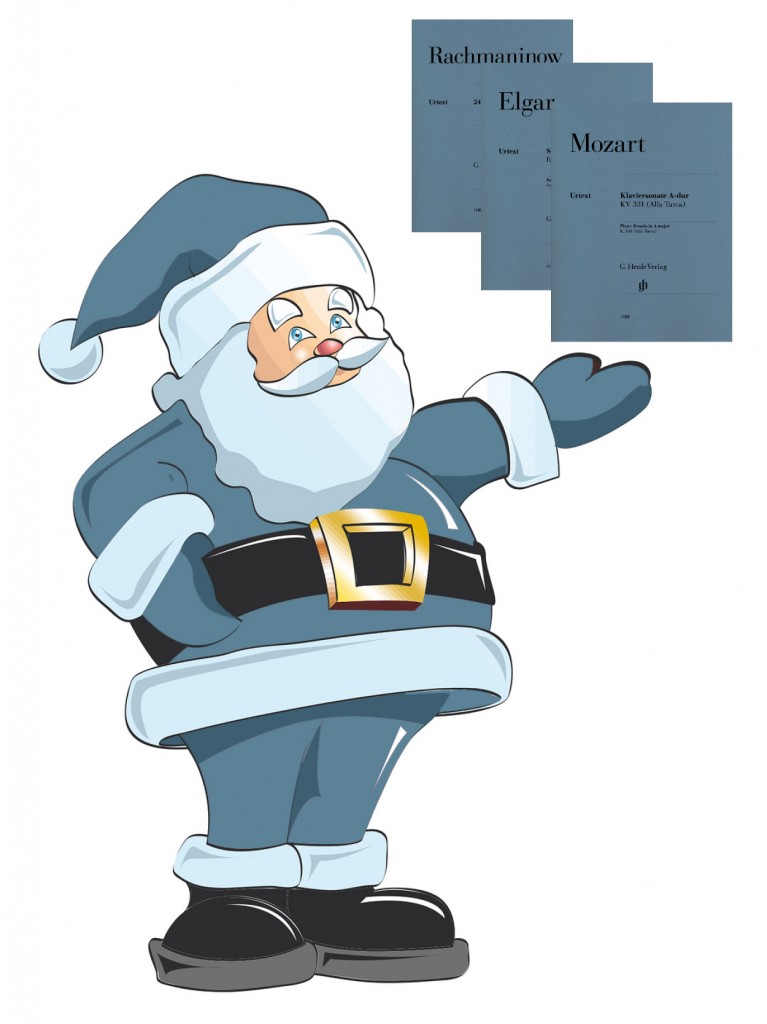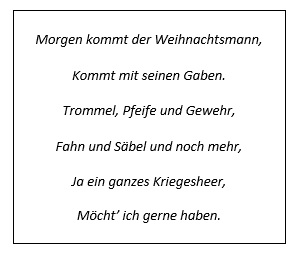Lights sparkle, candles glow, children’s eyes shine…it’s Christmastime again. Anticipation is growing, children are waiting for Santa Claus who – please, pretty please! – is supposed to bring them many presents.
So, this is already how the song Morgen kommt der Weihnachtsmann [“Santa Claus is Coming Tomorrow”] goes, as in the poem that the German poet Hoffmann von Fallersleben wrote in 1835, titled “Der Weihnachtsmann“ [“Santa Claus”]. It first appeared in 1837, though with a melody by Ernst Heinrich Leopold Richter that is no longer heard much today. The piece first became well-known sung to the melody of a salon lied, Ah! vous dirai-je, Maman, that was extremely popular at the time; the tune was used in innumerable arrangements, including Mozart’s famous piano variations K 265. In the Anglo-Saxon world the melody is best known from the song Twinkle Twinkle Little Star, whose text by Jane Taylor first appeared in 1806 in the poetry anthology Rhymes for the Nursery.
Like the melody, the meaning of the Fallersleben text has undergone change in recent decades: Instead of war toys, today’s children prefer railways and cuddly stuffed animals.
Not only is the song about the dear Santa subject to change, but also the very idea of Santa Claus itself looks back on a long history. The Santa myth originated primarily with Bishop Nicholas (Saint Nicholas), who was worshipped as a gift-bearer. The religious context, however, had become less and less important by the mid 19th century. Instead of episcopal robes, Santa now wore a Santa suit and fur-trimmed hat and was portrayed with a beard and cap, though deviating considerably from his now familiar sight – for example, he used to be suited up in green or blue as well as red.
A persistent myth says that Santa Claus was the invention of an American soft-drink producer. Even if this account is not correct, it has nevertheless lastingly influenced our present-day image of Santa: For, to promote his product in 1931, the beverage manufacturer commissioned the graphic designer Haddon Sundblom to draw Santa Claus in red and white – the colours of Coca-Cola.
 Nowadays, hardly anyone can imagine Santa Claus in other colours. So, it’s time to change that. We at Henle uphold, of course, the colour blue. And because it’s Christmas, we wish this year to put Santa Claus back into a blue suit. Perhaps, he’ll even have some blue music scores in his backpack….
Nowadays, hardly anyone can imagine Santa Claus in other colours. So, it’s time to change that. We at Henle uphold, of course, the colour blue. And because it’s Christmas, we wish this year to put Santa Claus back into a blue suit. Perhaps, he’ll even have some blue music scores in his backpack….
We wish you a Merry Christmas and Happy New Year!
Your Henle Bloggers,
Norbert Gertsch
Peter Jost
Norbert Müllemann
Annette Oppermann
Dominik Rahmer
Wolf-Dieter Seiffert





I got a copy of Chopin “At the piano” for Christmas. It’s brilliant!